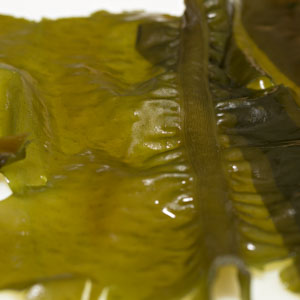Summer Soba Salad

introduction
For us, nothing tastes of summer like soba. With faint notes of black walnut and sweet herb, rich back-garden dirt and wildflowers, good soba possesses a palate impact as lush as an Impressionist’s field and a flavor that says “ancient.”
Bathed in an aromatic dashi broth with the vibrant emerald accents of lightly pickled cucumbers and raw okra, chopped scallions, and seaweed, soba goes all quenching and slurpy. You could chopstick it for days and experience no bloat or shame. Enjoy poolside with well-crafted dry Riesling from the Pacific Northwest.
Cooking Remarks
We serve these noodles at room temperature with a chilled sauce that starts with dashi, a broth flavored with katsuobushi (dried bonito flakes) and kombu (dried kelp). We cool the dashi and add sparkling liquid aromatics—shoyu (Japanese soy sauce), mirin (rice wine), and a few drops of rice vinegar. (These ingredients are available in specialty markets and online.)
Fresh raw okra sliced and put in touch with just a few drops of rice vinegar becomes a vibrant salad component here—think garden, not gumbo. It is important that the okra be slim and young and feel yielding, not stiff to the touch.
Japanese cucumbers are absolutely brilliant in this dish, but not always easy to find. Should you find them, they need not be peeled. Persian cucumbers might be more widely available in markets near you; they, too, do well.
We use dried wakame sold in ribbons, not in flakes, that we rehydrate and cut into slender strips that integrate nicely with the noodles. A good alternative to wakame is seasoned nori cut into fine threads with scissors. Mound the threads onto the portioned soba after sprinkling with the benne seeds.
equipment mise en place
For this recipe, you will need digital kitchen scale; a small saucepan; a fine-mesh strainer; a 2-cup liquid measuring cup; a vegetable peeler; a pint-size glass jar and a half-pint glass jar, both with lids; a small bowl; and individual serving bowls.
-
for the sauce:
-
0.4ounce dashi kombu
-
0.5ounce katsubushi, preferably wide-shaved
-
2cups spring or filtered water
-
3tablespoons Japanese soy sauce
-
2tablespoons mirin
-
1teaspoon rice vinegar
-
½teaspoon sugar
-
-
for the pickled cucumber:
-
1(8-ounce) piece hothouse, Japanese, or Persian cucumber
-
3tablespoons rice vinegar
-
1½teaspoons sugar
-
⅜teaspoon fine sea salt
-
⅛teaspoon finely grated fresh ginger
-
-
for the pickled okra:
-
3ounces slender, tender okra
-
1tablespoon rice vinegar
-
¼teaspoon sugar
-
⅛teaspoon fine sea salt
-
-
-
2strips dried wakame
-
1recipe Soba, cooked and drained
-
3 scallions
-
Anson Mills Sea Island Benne Seeds, toasted, for garnish
-
-
Make the sauce: Wipe the kombu with a damp paper towel. Place it in a small saucepan, add the water, and heat slowly over medium heat. When the water is just shy of simmering (do not let it reach a boil), remove the kombu and transfer it to a small bowl. (The kombu can be reused for a subsequent milder-tasting brew of dashi.) Increase the heat to medium-high. Just as the liquid begins to boil, stir in the katsuobushi. Cover the pan, turn off the heat, and let stand for 5 minutes.
-
Set a fine-mesh strainer over a small heatproof bowl or 2-cup measuring cup; you will have about 1½ cups of dashi. Stir in the soy sauce, mirin, vinegar, and sugar. Cover and refrigerate until chilled and ready to serve.
-
Make the pickled cucumber: If you’re using an English cucumber, stripe the piece at regular intervals with a vegetable peeler. No matter what type of cuke you’re using, cut it in half lengthwise and scrape out the seeds with a spoon. Cut each half in half lengthwise, and then slice each piece crosswise into ¼-inch-thick fans (fig. 3.1). Put the slices into a pint-size glass jar. In a small bowl, combine the vinegar, sugar, salt, and ginger and stir until the sugar and salt dissolve. Pour the liquid over the cucumbers and seal the jar. Refrigerate for 4 hours, turning the jar once or twice.
-
Make the pickled okra: Wipe the okra with a damp paper towel. Trim off and discard the tips and stem ends, and then cut the okra crosswise into ⅛-inch-thick slices. Turn the okra into a half-pint glass jar (fig. 4.1). In a small bowl, combine the vinegar, sugar, and salt and stir until the sugar and salt dissolve. Pour the liquid over the okra and seal the jar. Refrigerate for 4 hours, turning the jar upside down once or twice.
-
In a small bowl, soak the wakame in water to cover for 5 minutes, and then drain. Bring a small saucepan of water of boil over high heat. Drop the seaweed into the water, lower the heat slightly, and simmer the wakame until softened, 2 to 3 minutes. Drain and transfer to paper towels. Now rehydrated, the wakame strips will unfurl into ragged sheets (fig. 5.1). Trim the wakame to create planks, and then slice the planks into ⅛-thick-wide strips. Trim the strips into 3-inch lengths (fig. 5.2).
-
Divide the cooked soba among 4 individual bowls. Sprinkle with the pickled cucumbers and okra and the wakame, dividing them evenly. Finely chop the scallions and sprinkle them over. Ladle about ⅓ cup of the sauce into each bowl, sprinkle with benne seeds, and serve.
-
-
3.1

-
-
-
4.1

-
-
-
5.1

-
5.2

-